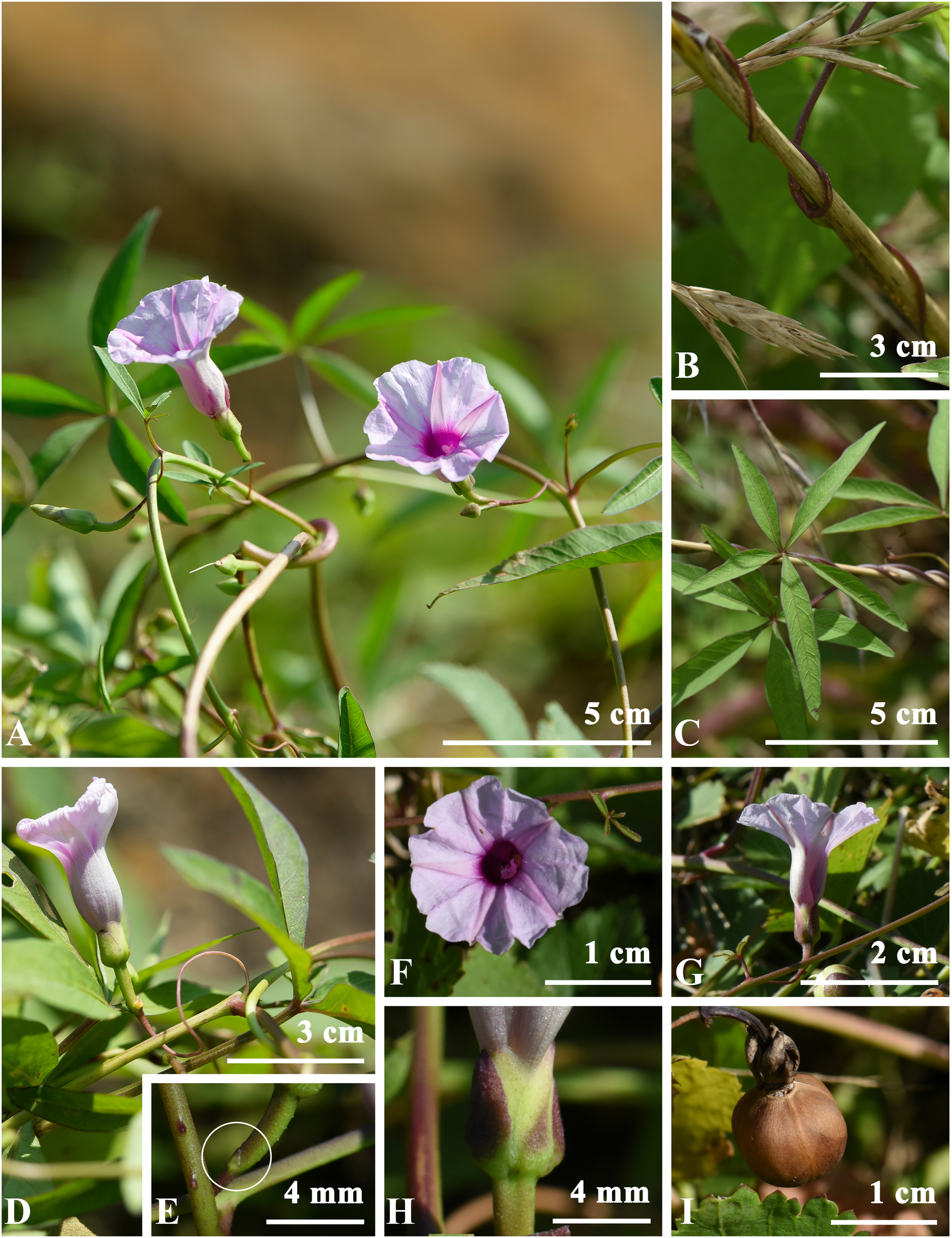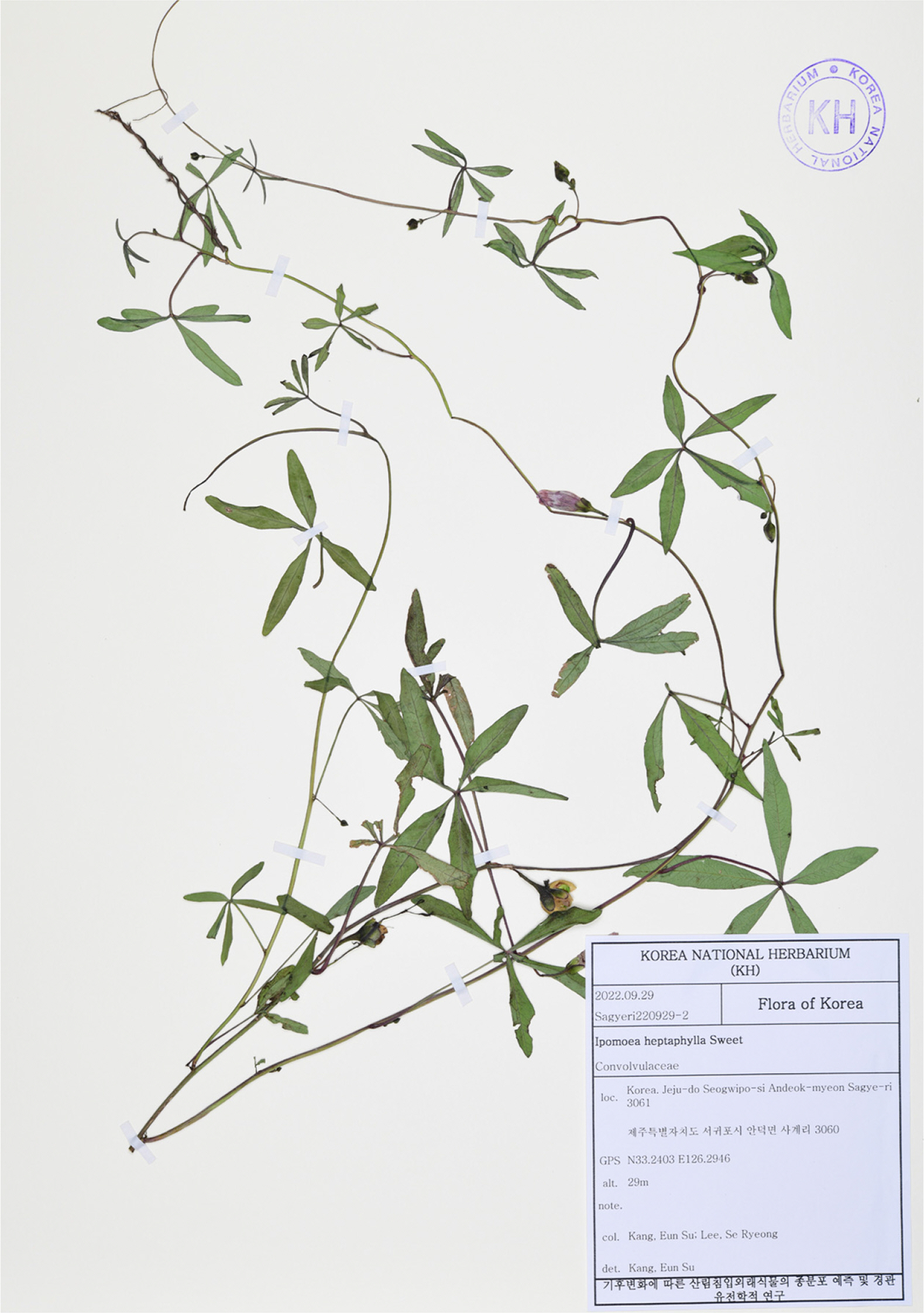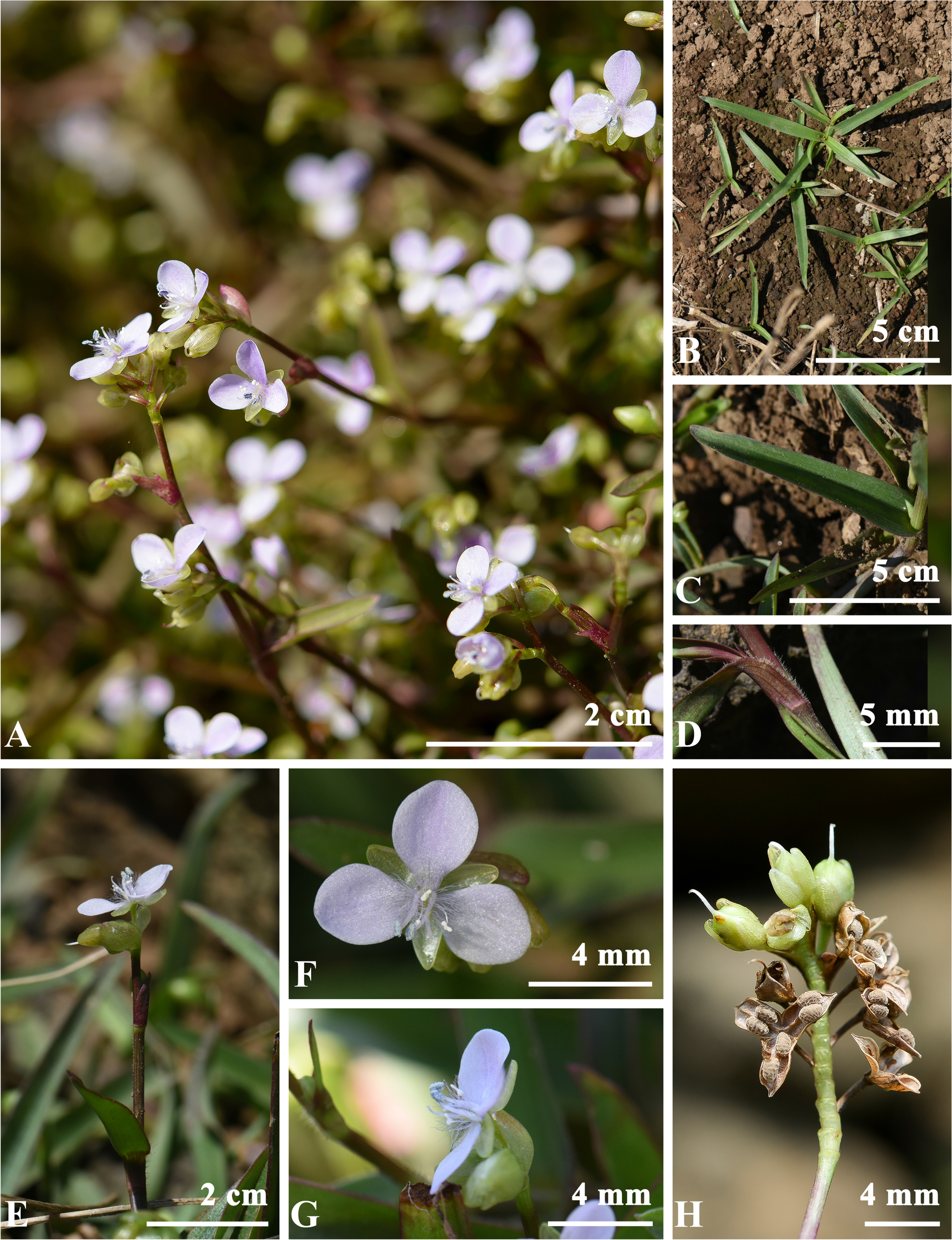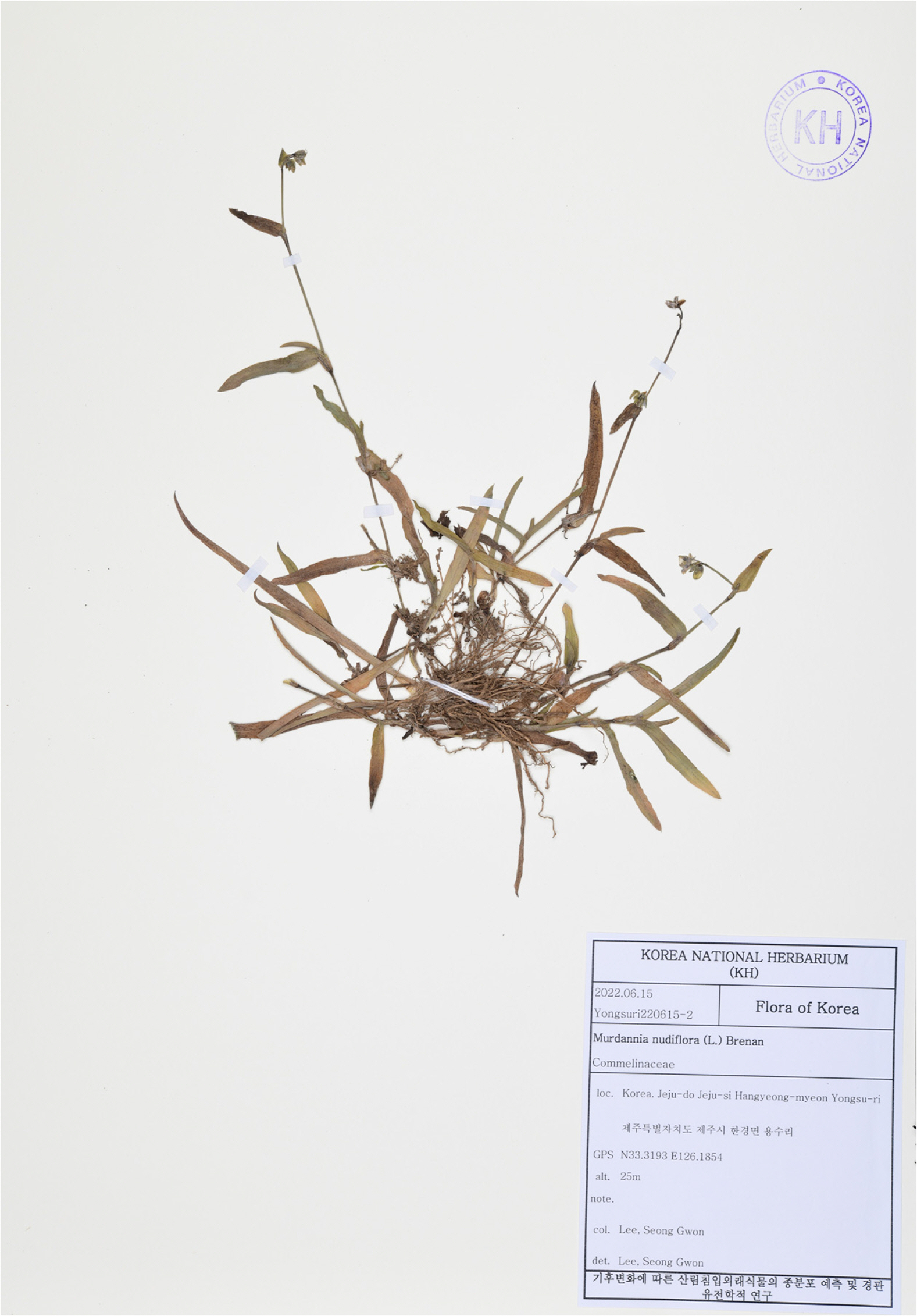/home/virtual/kjpt/journal//../xmls/kjpt-53-3-222.xml
KANG, KIM, SON, YIM, and JI: Ipomoea heptaphylla and Murdannia nudiflora: New records for the flora of Korea
Abstract
Ipomoea heptaphylla Sweet and Murdannia nudiflora (L.) Brenan have been discovered on arable land on Jejudo Island, Korea. Ipomoea heptaphylla can easily be distinguished from other Korean Ipomoea species by certain distinctive features, which include thin and coiled long pedicels, small corollas, and, most importantly, palmatisect leaves with five to seven lobes. Murdannia nudiflora is characterized by the absence of a rhizome, the presence of caducous bracteoles, by its bearing of more than one flower, and by its fruits with two seeds per valve and foveolate-reticulate seeds, distinguishing it from M. keisak. In this study, we report the plants I. heptaphylla and M. nudiflora and provide their morphological descriptions, photographs, distribution, and keys.
Keywords: Ipomoea, Ipomoea heptaphylla, Jeju-do Murdannia, Murdannia nudiflora, new record
INTRODUCTION
Convolvulaceae is a large family that includes approximately 60 genera and 1,700 taxa worldwide and is mainly distributed in tropical and temperate regions ( Stefanović et al., 2002; Felger et al., 2012; Meira et al., 2012). The plants are twining and annual or perennial herbs that have the following morphological characteristics: leaves - alternate, simple to lobed; flowers - actinomorphic, hypogynous, corollas sympetalous, two carpels united, unlobed, and 2–4 ovules per locule ( Stefanović et al., 2002). The major genera of Convolvulaceae are Convolvulus L. and Ipomoea L., of which approximately 800 species belong to Ipomoea, accounting for half of the Convolvulaceae taxa ( Meira et al., 2012; Wood et al., 2020). This genus was constituted without clear-defined delimitation from Convolvulus by Linnaeus ( Wood et al., 2020). Since then, taxonomists have arbitrarily classified Convolvulaceae taxa into Ipomoea or Convolvulus without specific distinction or have included all species of Ipomoea in Convolvulus ( Wood et al., 2020). In the late 18th century, Robert Brown suggested that the stigma of the pistil could be used to clearly distinguish the two genera ( Wood et al., 2020): Ipomoea species have a capitate stigma, which is 2–3 lobed, whereas Convolvulus species have two filiform stigmas ( Wood et al., 2020). The Commelinaceae family, comprising 50 genera and 700 taxa, has a cosmopolitan distribution but is particularly diverse in tropical and temperate regions. The plants possess morphological features, such as prominent leaf sheaths, succulent stems and leaves, and 3-merous petals and sepals. ( Evans et al., 2000; Hong, 2000; Fukuoka and Iwatsuki, 2016).
Murdannia Royle is a major genus of Commelinaceae, with approximately 52 known taxa ( Ancy, 2014; Pellegrini et al., 2016; Veena and Nampy, 2019). All Murdannia species were previously included in Aneilema R. Br. by Robert Brown and mainly classified as the subgenus Tricarpellaria owing to the characteristic of fruits having three valves ( Brenan, 1952; Morton, 1966). However, Brenan (1952) showed that they differed in the shape and structure of their flowers and capsules; hence, most species of the subgenus Tricarpellaria were separated from Aneilema and classified as Murdannia ( Morton, 1966). Murdannia and Aneilema can be also distinguished based on their antherodes ( Brenan, 1952; Ancy, 2014). Murdannia usually has 3-lobed or hastate antherodes, which are absent in some species, such as M. tenuissima (L.) Brenan and M. dimorpha (Dalzell) G. Brückn, while Aneilema has 2-lobed antherodes ( Brenan, 1952; Ancy, 2014).
Eight taxa of Ipomoea are distributed in Korea: Ipomoea coccinea L., I. cristulata Hallier f., I. quamoclit L., I. nil (L.) Roth, I. purpurea (L.) Roth, I. hederacea Jacq., I. triloba L., and I. lacunosa L. Among these, I. quamoclit L. is a cultivated plant, while the others are alien plants ( Kang et al., 2020; Korea National Arboretum, 2023a). Murdannia has only one native species, that is, M. keisak (Hassk.) Hand.-Mazz. ( Korea National Arboretum, 2023b). In this study, we report the unrecorded two alien plants, Ipomoea heptaphylla Sweet and Murdannia nudiflora (L.) Brenan, found in Jeju-si and Seogwipo-si, Jejudo Island, as new distributional records for the flora of Korea. We also provide detailed morphological descriptions, photographs, distributions, and taxonomic keys.
MATERIALS AND METHODS
To ensure accurate identification and provide comprehensive morphological descriptions, we conducted a thorough investigation of relevant literature, illustrations, and voucher specimens of I. heptaphylla and M. nudiflora deposited in various herbaria ( Brenan 1952; Stefanović et al., 2002; Ancy, 2014; Wood et al., 2020). For detailed observations, we utilized specimen and image data collected between 2021 and 2022. Images were captured using a digital camera (Nikon D810 + Nikon 105 mm AF Micro, Nikon, Tokyo, Japan). Morphological characteristics were measured using a digital Vernier caliper (Mitutoyo 500-196-30 absolute digimatic Vernier caliper; Tokyo, Japan), and the examined Korean materials were deposited at the Korea National Arboretum (KH) and National Science Museum of Korea (NSMK). The terminology regarding plant morphology used in this paper follows that of Harris and Harris (2011) and Wood et al. (2020).
RESULTS
Ipomoea heptaphylla Sweet, Hort. Brit. [Sweet], ed. 2: 372, 1830 ( Figs. 1, 2).–TYPE: Icon. no. 1950, Roxburgh s.n. (lectotype: K, Photo!, designated by Verdcourt, 1961).
Ipomoea wrightii A. Gray, Syn. Fl. N. Amer. 2: 213, 1878.
Korean name: 갈래잎나팔꽃(Gal-rae-ip-na-pal-kkot).
English name: Wright’s morning glory.
Herbs annual. Stems twining, glabrous. Leaves petiolate, petiole 1.6–5.3 cm long; usually palmatisect, 5–7 lobed, trifid terminally; lobe narrowly lanceolate, 2.2–5.7 cm long, 0.3–1.2 cm wide, apex acuminate, base attenuate, margin entire. Inflorescence axillary, solitary, rarely paired; peduncles 3.2–5.8 cm long, slender, flexuose, coiled; bracteoles minute, scale-like, caducous; pedicels shorter and stouter than peduncles. Flowers actinomorphic, hypogynous; sepals 5, outer sepals 3, inner sepals 2, subequal, ovate to oblong, 4.4–5.6 mm long, 2.8–3.9 mm wide, apex obtuse, margin entire, scarious; corollas sympetalous, funnel-form, 1.2–1.9 cm long, pink, glabrous; stamens 5; carpels 2, united, unlobed, ovules 2 per locule; Fruits capsule, ovoid, 0.9–1.2 cm diameter. Seeds 4.2–5 mm long, 1.9–2.5 mm wide, tomentose.
Flowering and fruiting: September–October.
Distribution: United States, Mexico, Guatemala, Cuba, Dominican Republic, Venezuela, Brazil, Colombia, Peru, Bolivia, Paraguay, Uruguay, Egypt, India, China, South Korea.
Distribution in South Korea: Jeju-do (Seogwipo-si).
Specimens examined: U.S.A. Alabama: Autauga County, 21 Sep 2017, M. R. Parker 1291 (UWAL 0046275); 21 Sep 2017, M. R. Parker 1291 (TROY 00048190). Barbour County, 3 Sep 2011, B. Dykes 90 (TROY 00033266). Louisiana: Ville Platte, 20 Aug 2020, B. S. Early, A. Fontenot and B. Fontenot 1908.1 (LSU 00216600).
KOREA. Jeju-do: Seogwipo-si, Andeok-myeon, Sagye-ri, 29 Sep 2022, E. S. Kang and S. R. Lee Sagyeri220929-1, Sagyeri220929-2, Sagyeri220929-3, Sagyeri220929-4 (KH 3000109, 3000110, 3000111, 3000112); 13 Oct 2022, E. S. Kang and S. R. Lee Sagyeri221013-1, Sagyeri221013-2 (KH 3000113, 3000114).
Taxonomic note: The flowers of I. heptaphylla are smaller than those of I. hederacea, I. nil, and I. purpurea. Corolla length is less than 2 cm ( Fig. 1F, G), which is similar to that of I. lacunosa and I. triloba ( Wood et al., 2020). However, I. heptaphylla differs from I. lacunosa and I. triloba in its inflorescence features. I. heptaphylla has long and slender coiled peduncles and typically bears one flower, rarely a pair ( Fig. 1D–E). In contrast, I. lacunosa and I. triloba have shorter, stouter, and erected peduncles with 1– 3 and 1–8 flowers, respectively ( Wood et al., 2020). Notably, I. heptaphylla usually has palmatisect leaves with 5–7 lobes ( Figs. 1C, 2); thus, it can be readily distinguished from all Ipomoea taxa in Korea that have simple or trifid leaves.
Key to the species of Ipomoea in Korea
1. Corolla hypocrateriform, red or orange; stamens exserted.
1. Corolla funnelform, purple, blue, pink, or white; stamens not exserted.
4. Leaves usually palmatisect with 5–7 lobes, trifid terminally; peduncle coiled ·········································· ·························· I. heptaphylla Sweet 갈래잎나팔꽃 4. Leaves simple or trifid; peduncle not coiled.
5. Corolla length less than 2 cm.
8. Pilose to glabrous; peduncles not branched; flowers 1–3 ······································· I. lacunosa 애기나팔꽃 8. Pilose to glabrescent; peduncles branched; flowers 1–8 ··············································· I. triloba 별나팔꽃
Murdannia nudiflora (L.) Brenan, Kew Bull. 7: 189, 1952 ( Figs. 3, 4).—TYPE: India. s.loc., s.die, Osbeck s.n. (lectotype: LINN 65.12 Photo!, designated by Merrill and Dandy, 1937).
Commelina nudiflora L., Sp. Pl.: 41, 1753; Aneilema nudiflorum (L.) Sweet, Hort. Br.: 430, 1826; Ditelesia nudiflora (L.) Raf., Fl. Tellur. 3: 69, 1837; Phaeneilema nudiflorum (L.) G. Brückn., Notizbl. Bot. Gart. Berlin-Dahlem 10: 56, 1927.
Korean name: 우영사마귀풀(U-yeong-sa-ma-gwi-pul).
English name: Nakedstem dewflower.
Herbs annual. Roots rhizomes absent, fibrous, roots at the nodes. Stems erect to decumbent, rarely branched. Leaves alternate, sessile; sheath glabrous, ciliate; leaf blade oblong-linear to lanceolate-linear, 2.5–7.3 cm long, 0.4–0.6 cm wide, apex acute, base rounded, margin entire, scabrous, usually undulate, glabrous, ciliate. Inflorescence cincinnus, axillary or terminal, solitary, rarely paired terminally; bract leaf-like; bracteoles caducous; more than 1 flower. Flowers zygomorphic, andromonoecious; sepals 3, ovate or elliptic, 1.5–3.0 mm long, 1.3–1.4 mm wide, pale green, glabrous; petals 3, ovate, 5.1–7.4 mm long, 4.8–5.7 mm wide, white to pale pink; stamens 2, antesepalous, dorsifixed, filaments pale pink to purple, base stouter, densely bearded with pink to purple hair, anthers blue or purple, pollen white to pale yellow; staminodes 2–4, antepetalous 3, antesepalous 1, filaments glabrous to slightly haired, white to pale pink, antherodes 3-lobed, white to pale yellow; pistil 1, ovary elliptic, style curved, glabrous. Fruits capsule, ovate, 3.2– 3.8 mm long, 2.3–3 mm wide, valves 3, seeds 2 per valve.
Seeds oblong, 1.2–1.3 mm long, 1–1.1 mm wide, foveolate-reticulate, brown.
Flowering and fruiting: June–November.
Origin: Asia (Pakistan, India, Myanmar, China, Indonesia, Philippines, Bangladesh, Nepal, Papua New Guinea), Australia ( POWO, 2023).
Distribution: Pakistan, India, Myanmar, China, Indonesia, Philippines, Bangladesh, Nepal, Papua New Guinea, Australia, United States, Mexico, Cuba, Dominican Republic, Guatemala, Panama, Venezuela, Brazil, Colombia, Bolivia, Uruguay, Suriname, Japan, South Korea.
Distribution in South Korea: Jeju-do (Jeju-si), Daejeon-si, Gyeongbuk-do (Andong-si).
Specimens examined: PUERTO RICO. Luquillo, 25 Jan 1990, C. M. Taylor 9886 (NY 992653); 13 Sep 1979, A. H. Liogier 29287 (NY 992654); 20 Mar 1980, A. H. Liogier 30471 (NY 992656).
BRAZIL. Acre: Rio Branco Mun, 11 Feb 2007.
COSTA RICA. Puntarenas: Golfito, 17 Oct 2001, R. Aguilar 6585, 6589 (NY 1293016, 1293019).
U.S.A. Arkansas: Hempstead County, 4 Oct 1997, R. D. Thomas 155570 (NY 3734543); Florida: Brevard County, 13 Oct 2002, S. Myers 474 (USF 215309), 23 Sep 2002, P. L. Howell 561 (USF 233134).
MEXICO. Oaxaca: San Cristobal Amatlán, 19 Aug 1995, J. S. Martínez 263 (USF 218852).
KOREA. Jeju-do: Jeju-si, Hankyung-myeon, Yongsu-ri, 15 Jun 2022, S. G. Lee Yongsuri220615-1, Yongsuri220615-1 (KH 3000116, 3000117). Daejeon-si: Daejeon-si, Yuseong-gu, Doryong-dong, 24 Aug 2022, M. Y. Yim s.n. (NSMK); Daejeon-si, Yuseong-gu, Guseong-dong, 29 Aug 2022, M. Y. Yim s.n. (NSMK). Gyeongbuk-do: Andong-si, Pungsan-eup, Maegok-ri, 17 Jul 2023, S. Jeong and G. Y. Chung Maegokri230717-1, Maegokri230717-2, Maegokri230717-3, Maegokri230717-4, Maegokri230717-5 (KH).
Taxonomic note: M. nudiflora is morphologically similar to M. keisak in its decumbent stem, roots at the node, linear to lanceolate leaf blade, and axillary or terminal inflorescence. However, the two species differ in their root, inflorescence, and capsule characteristics. M. nudiflora has no rhizomes, more than one flower (up to 12 in native regions, such as India), and bracteoles are caducous ( Fig. 3A, E, H). In contrast, M. keisak has rhizomes, usually one flower, and the bracteoles are persistent. In terms of fruits and seeds, M. nudiflora has smaller capsules than those of M. keisak, has two seeds per valve ( Fig. 3H), and the surface of the seeds is foveolate-reticulate. The capsules of M. keisak are more than 5 mm in length, and their valves contain 2– 4 slightly flattened seeds.
Key to the species of Murdannia in Korea
1. Root rhizome present; inflorescence usually 1-flowered, bracteoles persistent; capsule more than 4 mm long, with more than 2 seeds per valve; seeds slightly flattened ······· ················································ Murdannia keisak 사마귀풀 1. Root rhizome absent; inflorescence more than 1-flowered, bracteoles caducous; capsule less than 4 mm long, with 2 seeds per valve; seeds foveolate-reticulate ···················· ············································ M. nudiflora 우영사마귀풀
DISCUSSION
The origin of I. heptaphylla is unclear; however, it is presumed to be indigenous to tropical regions ( Felger et al., 2012; Wood et al., 2020; POWO, 2023). It is distributed throughout tropical and subtropical climates, including Florida, the Galapagos Islands, Egypt, and India. It was introduced into eastern China, which is geographically close to South Korea ( POWO, 2023). This plant grows mainly in dry environments and has a wide distribution, although this is not commonly observed ( Wood and Scotland, 2017; Wood et al., 2020). In Korea, I. heptaphylla was first discovered approximately 10 years ago at a cultivation site located in Sagye-ri, Seogwipo-si, Jeju-do. They were widespread in cultivation sites and their surroundings during the time of discovery, but their population gradually declined owing to weeding and other agricultural activities. Currently, only about 10 individuals can be observed growing in dry open soils next to the cultivation site. The palmatisect leaves of I. heptaphylla are a primary distinguishing feature that is not found in other Korean Ipomoea taxa; therefore, it was given the Korean name “Gal-rae-ip-na-pal-kkot.”
Murdannia nudiflora is native to tropical Asia and was introduced into Africa, the Americas, and Japan ( Ancy, 2014; Ahmed et al., 2015; POWO, 2023). The specific epithet “ nudiflora” presumably refers to its caducous bracteoles ( Ancy, 2014). M. nudiflora has several distinguishing characteristics that differentiate it from other Murdannia species, including its inflorescence carrying multiple flowers and fruits containing two seeds per valve ( Ancy, 2014; Atkinson, 2014) ( Fig. 3). Murdannia nudiflora, like other Commelinaceae taxa, thrives primarily in moist or water-rich soils. However, if its roots are stably established, it can survive and spread using creeping stems under dry soil conditions ( Atkinson, 2014).
Murdannia nudiflora is the third most notorious weed among the Commelinaceae. It is primarily found in cultivated fields with major crops, such as cotton, rice, and sesame, and can reduce crop productivity and lead to pest damage ( Atkinson, 2014; Ahmed et al., 2015; Veena and Nampy, 2019). In the U.S.A., M. nudiflora is a weed that requires active management because of its uncontrolled spread, which has led to the rapid expansion of its geographical range in the western regions ( Atkinson, 2014; Atkinson et al. 2019). Its ability to produce a large number of seeds and creeping stems that root at the nodes contribute to its invasiveness ( Atkinson, 2014; Atkinson et al. 2019).
Murdannia nudiflora was discovered at a cultivation site in Yongsoo-ri, Seogwipo-si, Korea, which was assumed to have been used for cultivating rice; therefore, it is likely that M. nudiflora seeds were unintentionally introduced in Jeju-do with imported rice. The species was recently confirmed to occur in Andong-si and Daejeon where, similar to Jeju-do, it is presumed to have been unintentionally introduced through human activities, such as cultivation, park development, and road construction. Since the species was initially found in Jeju-do and is predominantly growing in cultivated areas, it was given the Korean name “U-yeong-sa-ma-gwi-pul” (“U-yeong,” stemming from the Jejudo Island dialect, means vegetable garden).
The confirmed habitats of I. heptaphylla and M. nudiflora are managed agricultural areas, suggesting that they are unlikely to invade natural ecosystems or exhibit rapid spreading behavior. However, consistent monitoring is required to ensure accurate risk assessments and determine their naturalization statuses. In terms of cultivation, these aliens may impact crop productivity or causing pest damage. Therefore, measures to control these species and mitigate any potential negative effects on crop production or pest management need to be developed ( Ahmed et al., 2015).
ACKNOWLEDGMENTS
This study was supported by the “Research on taxonomy and distribution of invasive alien plants in Korea (KNA-1-2-39, 21-2)” project funded by the Korea National Arboretum, and research funds of the National Research Foundation of Korea (2022M3H9A1097179). We would like to express our gratitude to Seong Ik Kim, Seong Gwon Lee, and Sa Beom Jang for providing information on the natural habitat and collecting specimens.
Fig. 1.
Photographs of Ipomoea heptaphylla Sweet. A. Plant. B. Stems. C. Leaves. D. Inflorescence. E. Bracteoles. F–G. Flowers. H. Sepals. I. Fruits. 
Fig. 2.
Voucher specimen of Ipomoea heptaphylla Sweet (KH). 
Fig. 3.
Photographs of Murdannia nudiflora (L.) Brenan. A. Plant. B. Shoots. C. Leaves. D. Sheath. E. Inflorescence. F, G. Flowers. H. Fruits and seeds. 
Fig. 4.
Voucher specimen of Murdannia nudiflora (L.) Brenan (KH). 
Literature Cited
Ahmed, S. Opeña, J. L and Chauhan, B. S. 2015. Seed germination ecology of doveweed ( Murdannia nudiflora) and its implication for management in dry-seeded rice. Weed Science 63: 491-501.  Ancy, A. A. 2014. Taxonomic revision of the genus Murdannia Royle (Commelinaceae) in India. Ph. D. dissertation,. Calicut University; Kerala, India. 343.
Atkinson, J. L. 2014. Biology, ecology, and control of doveweed (Murdannia nudiflora [L.] Brenan). Ph. D. dissertation. Clemson University; Clemson, SC, USA. 102.
Atkinson, J. L. McCarty, L. B. Yelverton, F. McElroy, S and Bridges, W. C. 2019. Doveweed ( Murdannia nudiflora) response to environmental resource availability and cultural practices. Weed Science 67: 214-220.  Brenan, J. P. M. 1952. Notes on African Commelinaceae. Kew Bulletin 7: 179-208.  Evans, T. M. Faden, R. B. Simpson, M. G and Sytsma, K. J. 2000. Phylogenetic relationships in the Commelinaceae: I. A cladistic analysis of morphological data. Systematic Botany 25: 668-691.  Felger, R. S. Austin, D. F. Van Devender, T. R. Sánchez-Escalante, J. J and Costea, M. 2012. Convolvulaceae of Sonora, Mexico. I. Convolvulus, Cressa, Dichondra, Evolvulus, Ipomoea, Jacquemontia, Merremia, and Operculina
. Journal of the Botanical Research Institute of Texas 6: 459-527.
Fukuoka, N and Iwatsuki, K. 2016. Commelinaceae. Flora of Japan, Vol. 4b. Iwatsuki,, K. Boufford, D. E. Ohba, H (eds.), Kodansha, Tokyo. 46-51.
Harris, J. D and Harris, M. W. 2011. Plant Identification Terminology: An Illustrated Glossary. 2nd ed. Spring Lake Publishing, Spring Lake. 206 pp.
Hong, D. 2000. Commelinaceae. Flora of China. 24: Wu, Z. Y. Raven, R. H (eds.), Science Press, Beijing and Missouri Botanical Garden Press, St. Louis, MO. 39-133.
Kang, E. S. Lee, S. R. Oh, S. H. Kim, D. K. Jung, S. Y and Son, D. C. 2020. Comprehensive review about alien plants in Korea. Korean Journal of Plant Taxonomy 50: 89-119 (in Korean).   Meira, M. da Silva, E. P. David, J. M and David, J. P. 2012. Review of the genus Ipomoea: Traditional uses, chemistry and biological activities. Revista Brasileira de Farmacognosia 22: 682-713.  Merrill, E.D. 1937. The Chinese species described in Meyen’s “Observationes Botanicae” (Beiträge Zur Botanik). Journal of the Arnold Arboretum 18: 54-77.  Morton, J.K. 1966. A revision of the genus Aneilema R. Brown (Commelinaceae) with a cytotaxonomic account of the West African species. Botanical Journal of the Linnean Society 59: 431-478.  Pellegrini, M. O. O. Faden, R. B and de Almeida, R. F. 2016. Taxonomic revision of Neotropical Murdannia Royle (Commelinaceae). PhytoKeys 74: 35-78.
Stefanović, S. Krueger, L and Olmstead, R. G. 2002. Monophyly of the Convolvulaceae and circumscription of their major lineages based on DNA sequences of multiple chloroplast loci. American Journal of Botany 89: 1510-1522.   Veena, V and Nampy, S. 2019. Induced cleistogamy: A strategy for reproductive assurance in Murdannia nudiflora (Commelinaceae). Botany 97: 547-557.  Verdcourt, B. 1961. Notes from the East African Herbarium: XII. Kew Bulletin 15: 1-18.  Wood, J. R. I. Muñoz-Rodríguez, P. Williams, B. R. M and Scotland, R. W. 2020. A foundation monograph of Ipomoea (Convolvulaceae) in the New World. PhytoKeys 143: 1-823.  
|
|















